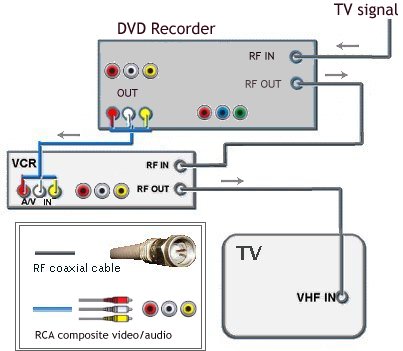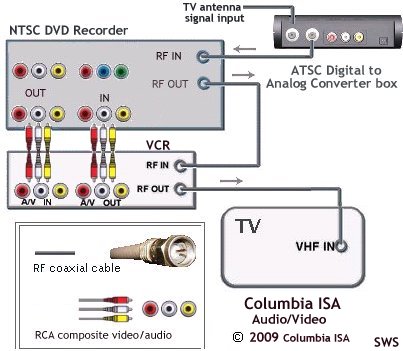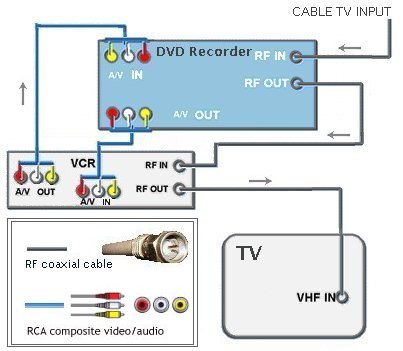
 |
| Diagram
Index
Connect a DVD recorder and a VCR to a TV with only an RF input jack. Components: o Analog Cable TV signal source IN. o TV set (not cable ready and can only tune VHF and UHF). o Three RF coaxial cables. o One (or two) set(s) of Audio/Video RCA cables (1-yellow composite video, 1-red & 1-white audio). o DVD recorder. o VHS VCR. For years many TV viewers have had a setup which consists of analog cable TV, a standard analog TV set without any input connections except an RF antenna jack, and a standard analog VCR. Typically the VCR was cable ready meaning you could eliminate your cable tuner box and use the VCR to tune in stations, or if you had a TV set which was cable ready you did not even need to use the VCR for a tuner and could watch TV using only the TV tuner. In any case, the new addition to this standard setup for many people is a DVD recorder. With DVD there are no more tangled cassette tape jams, and you have direct access to scenes and no more rewinding. DVD is also more robust than videotape and gives a better picture. Wouldn't it be great to combine both VCR and DVD into your existing setup. Just add the DVD recorder ahead of your VCR with the cable INPUT going into the DVD recorder instead of the VCR. There are alternate ways to configure a DVD recorder into a TV/VCR setup, this is only one way and it may not be the best way due to Macrovision copy protection regarding the VCR, but it will work for most things you'll want to do. The best way to play DVD-Video (Hollywood movies) is to hookup your DVD player/recorder directly to your TV and not thru a VCR. 
Why would you want this configuration? If you have an old TV set with only an RF input and you do not want to buy an RF modulator, you could do almost all of the things you could do normally with a more conventional configuration. What can you do with this configuration? o Play a CD and hear music on TV, o Play a VHS tape and view on TV, o Play a DVD-R or DVD-RW that you recorded from cable TV, o Record a TV show to DVD, o Record a TV show to VHS tape, o Watch TV only, o Record a backup copy or "archive" of a DVD (you recorded) to VHS tape, o Watch one TV show while recording another, o Copy a VHS tape (you recorded) over to a DVD. Also, within Macrovision restrictions, and depending on the hardware you have, play a commercial DVD-Video (movie). Of course, you can always buy an RF modulator ($20) and hookup your DVD recorder to your TV directly to get perfect DVD-video viewing with no concern about Macrovision. (Your TV does not have the AGC circuit like a VCR does and therefore does not get "fooled" into making unnecessary adjustments which cause the degraded picture) While it is also possible to record a commercial DVD-Video (movie) to VHS tape, doing so will result in a very poor and virtually un-viewable video presentation due to Macrovision copy protection. See below for possible solutions. What settings do you need for this configuration? The TV will need to be on channel 3 or channel 4 in order to get the VCR's output. The VCR will need to be set to Line 1 (L1) in order to get the DVD's output. (Line 2 could also be used) Cable configuration explanation The RF coax cable signal from the cable TV company is available to the DVD recorder, the VCR and the TV. What this means is you can record TV shows to DVD or VHS and play them back on the TV. With the digital TV transition in Feb. 2009, a converter box is needed for over-the-air TV signals. The following diagram shows how to connect the box into your existing setup.  Tune channels on the converter box using its remote. The converter box will output on channel 3 (or 4) so the DVD recorder should be set to channel 3 (or 4) and the TV as well. RF Modulator ::RF Modulator hookup diagram DVD Video Copy Protection Both analog and digital protection are available for DVD Video. Analog Protection: What is Macrovision DVD copy protection? Macrovision is a company which creates copy protection schemes and Macrovision also refers to the copy protection process used on DVD-Video. Macrovision is activated during the DVD authoring stage (when the disc content is created) by setting certain Macrovision copy control bits to the ?on? position. When a replicated disc, with these bits set, is played back in a home DVD player/recorder, the digital-to-analog converter chip within the DVD player applies the Macrovision copy protection to the outgoing signal, causing any copies made on 95% of VCRs in the marketplace to be substantially distorted. There are three levels of Macrovision copy protection. Level 1: The alternating dark/bright effect with or without unstable video. Level 2: Striping in pink or purple lines Level 3: floating logo. Possible solutions: While level 1 can be overcome by a video stabilizer/enhancer box ($50) or a firmware modification, level 2 and level 3 must be disabled in the DVD players hardware (video chip) or corrected by a standalone TBC or color corrector. Some DVD players are firmware upgradeable by CD-R. If you can change the firmware, you may be able to turn Macrovision "off". You'll have to do some research here for your player. On some DVD players you may be able to replace the original video chip with a chip which is programmed to not enable Macrovision. Replacing the chip will only work for some players and you'll have to be very careful here and know exactly what you're doing or you may damage your player. How does Macrovision DVD copy protection work? The DVD movie sends a signal telling the DVD player to turn on Macrovision. Some older DVD players have "secret menus" where you can turn OFF Macrovision. All DVD players sold in North America require Macrovision capability built into them. DVDs implement Macrovision by attaching code to the video stream indicating whether or not to enable Macrovision protection. Then, when the DVD player outputs the frame, it adds Macrovision codes to the frame. Some people believe that Macrovision copy protection comes from the DVD itself. Other people believe that the Macrovision copy protection comes from the DVD player. Actually it is a combination of both in most cases. The DVD (commercial disc) has the job of attempting to turn on copy protection by using copy protect codes in it's data stream, but it is the DVD player hardware itself (video chip) that actually provides the means to induce picture distortion and other negative results. Some DVD players/recorders always put out distortion signals such as audio noise even when a DVD is not loaded in the hardware's tray (output thru a VCR to TV). If however you play a home recorded DVD of a regular TV show, the distortion stops. This is why a DVD-R you record yourself from a TV show for example, has no Macrovision and you can record it to VHS tape with no negative results. VHS Copy Protection Macrovision ACP is the most effective and widely used technology for preventing unauthorized copies of VHS tapes. This copy protection is added to the VHS copies during the duplication process. The process is completely transparent on the original tape, yet it effectively degrades unauthorized copies on the majority of all consumer VCR and TV combinations. When a consumer attempts to make a copy of a protected VHS tape, the technology confuses an electronic component (the AGC or Automatic Gain Control) in the recording VCR, weakening the signal and causing some or all of the following: dim and/or noisy pictures, loss of color, loss of video and picture tearing. In VHS technology, the Macrovision signal is encoded within the tape itself as part of the analog signal. This is not the case with DVD encrypted movies. Digital Protection: What is CSS (Content Scrambling System)? CSS is used to prevent piracy and impose regional viewing restrictions. A CSS-protected DVD consists of three main components: the DVD, the DVD player, and the host. CSS combines player-host mutual authentication and data encryption. The way in which CSS works can reduce piracy and prevent a DVD bought in the USA from playing on a device bought in Europe. CSS is not a foolproof system; however, by combining CSS with Macrovision the copy protection is maximized until something better is developed. Want to copy a VHS tape to DVD? You can copy (record) a DVD of any non-commercial videotape you have at home. If you have old TV shows like movies you recorded on VHS videocassette on your VCR, or your home videos of family and friends, you can transfer them over to a recordable DVD by using the hookup below.  The VCR plays the VHS tape and outputs to the DVD recorder. Put a blank DVD in the DVD recorder and a copy of the VHS tape is created. The VCR output goes to the DVD recorder input. The TV is used to monitor the process. The DVD recorder must be set to Line 1 (L1) to pickup the VCR's output. The VCR is set to Line 1 (L1) to pickup the DVD recorder's output. The VCR will pass the video and audio to the TV over the RF cable. If you try to copy a VHS tape which was recorded with Macrovision, and almost all commercial VHS tapes (Hollywood movies) are recorded this way for anti-copy protection, you will most likely fail in your attempt. Some DVD recorders will not even let you enter the record mode, let alone record anything. There are alternate methods of getting a commercial VHS tape over to DVD, however this gets more involved and will cost you. Products are available which involve a personal computer, editing and connections which will eventually output to a DVD. Also you can send your store-bought VHS movies to a professional video company for conversion to DVD but again this will cost you. Actual tests were done to verify results. DVD recorder used was the SONY RDR-GX7 VCR used was the Emerson EWV603 TV used was the 1979 SONY KV-1743R Columbia ISA - Audio Video Empowering consumers through information. Contact: columbiaisa@yahoo.com |